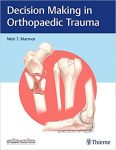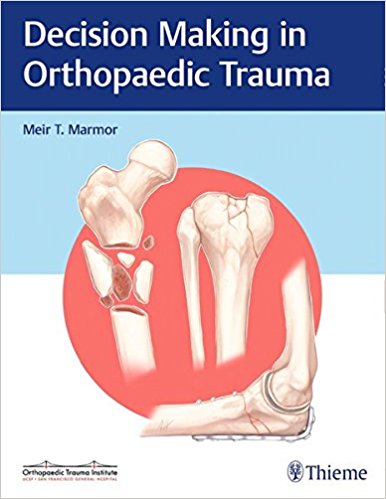 Editor: Meir T. Marmor, MD
Editor: Meir T. Marmor, MD
Publisher: Thieme – 172 pages, with 39 illustrations
Book Review by: Nano Khilnani
This book fills a great need for easily-accessible, available, and usable information by orthopedic surgeons on a large variety and number of procedures. Such information is not readily found in medical literature today.
The editor of this volume Dr. Meir Marmor writes: “Surgeons, physicians, nurses, therapists and medical staff who treat musculoskeletal injuries need to have a common language and understanding of the critical decisions and management options for the various injuries. However, this information is not easy to come by.”
“The information age in medicine has flooded the medical community with data on the effectiveness of medical treatments. At the same time, the demand for evidence-based medicine has increased the quality and sophistication of medical research, making the interpretation of medical research a task for the experts.”
“Existing websites and textbooks are not always approachable to the non-expert orthopedic trauma surgeon and often lack the simplicity to become useful for a large audience. In some instances, the caregiver treating orthopedic injury only wants to ask an expert in the field, ‘what would you do in these kinds of injuries?’ That is where this book comes in
Nineteen specialist experts including the editor, in specific kinds of orthopedic trauma, authored the 80 chapters of this extensive volume on trauma in orthopedics. We name the chapter titles below to provide you an overview of what you will find in it.
The contributors are all affiliated with the Orthopedic Trauma Institute at UCSF, and the Zuckerberg San Francisco General Hospital and Trauma Center in San Francisco, California.
- Compartment Syndrome (CS)
- Open Fracture Management
- Ballistic Injuries
- Vascular Injuries
- Traumatic Nerve Injury
- Mangled Extremity
- Polytrauma Patient
- Acute Pain Management
- Chronic Pain Management
- Venous Thromboembolism (VTE) Prevention
- VTE Prevention for Patients on Anticoagulation
- Embolic Disease Management
- Heteropathic Ossification (HO)
- Regional Anesthesia in Orthopedic Surgery
- Traumatic Anterior Shoulder Instability
- Acromioclavicular Separation
- Sternoclavicular Dislocation (SCD)
- Clavicle Fractures
- Scapulothoracic Dislocation (STD)
- Scapula Fractures
- Proximal Humerus Fractures
- Humeral Shaft Fractures
- Distal Humerus Fractures
- Elbow Dislocation / Terrible Triad Injury
- Radial Head Fractures
- Capitellum Fractures
- Olecranon Fractures
- Forearm Fractures
- Distal Radius Fractures
- Scaphold Fractures
- Perilunate Dislocation
- Extensor Tendon Lacerations
- Flexor Tendon Injuries
- Finger Replantation
- Finger Fractures
- Metacarpal Fractures
- Metacarpholangeal (MCP) Dislocations
- Phalanx Dislocations
- Femoral Shaft Fractures
- Distal Femur Fractures
- Traumatic Knee Dislocation
- Patella Fractures
- Tibial Plateau Fractures
- Tibial Shaft Fractures
- Tibial Plafond (Pilon) Fractures
- Ankle Fractures
- Talus Fractures
- Calcaneus Fractures
- Lisfranc Fractures
- Navicular Fractures
- Metatarsal (MT) Fractures
- Toe Fractures
- Pelvic Ring Fractures
- Acetabulum Fractures
- Hip Dislocations
- Femoral Head Fractures
- Femoral Introchanteric Fractures
- Femoral Neck Fractures
- Femoral Subtrochanteric Fractures
- Spinal Cord Injury (SCI)
- Adult C-Spine Clearance After Blunt Trauma
- Occipitocervical Dislocations (OCD)
- Atlas (C1) Fractures and Traverse Ligament Injuries
- C2 Odontoid (dens) Fractures
- C2 Traumatic Spondylothesis
- C#-C7 Facet Dislocations
- C3-C7 Lateral Mass Fractures
- Geriatric Vertebral Compression Fracture (VCF)
- Thoracolumbar Injuries
- Bisphosphonate Femur Fractures
- Pathological (Neoplastic) Fractures
- Periprosthetic Fracture THA: Acetabulum
- Periprosthetic Fracture around THA: Femur
- Periprosthetic Fracture around TKA: Femur
- Periprosthetic Fracture around TKA: Tibia
- Periprosthetic Fracture around Total Shoulder Arthroplasty (TSA)
- Fracture Delayed and Nonunion
- Acute Surgical Infection
- Post-Operative Chronic Infection
- Bone Defects
In each chapter, a visual schematic diagram is provided that contains boxes of different shapes and colors. By glancing at this graphic, the reader is able to understand the condition and injuries, and make a series of decisions on the available options and the proper courses of action for each case.
Dr. Marmor cautions that the chapters “are not a substitute for detailed comprehensive protocols of management of the various musculoskeletal conditions listed in the book.” Instead, the visual and textual information provided in the chapters are a sort of distillation to enable the surgeon to make the critical decisions necessary to handle each case.
This is an authoritative and extensive volume on orthopedic trauma with experts as contributors, and the unique mode of presentation of information sets it apart from others and makes if highly useful and effective.
Editor:
Meir T. Marmor, MD is with the Orthopedic Trauma Institute, the University of California San Francisco (UCSF), and the Zuckerberg San Francisco General Hospital and Trauma Center in San Francisco, California.







